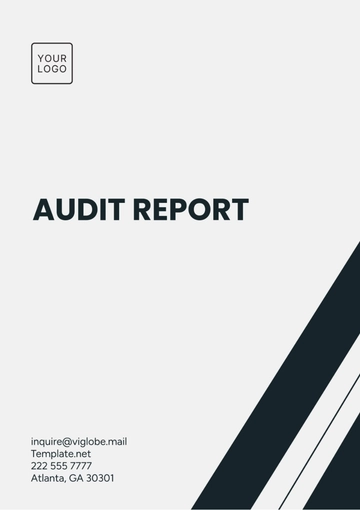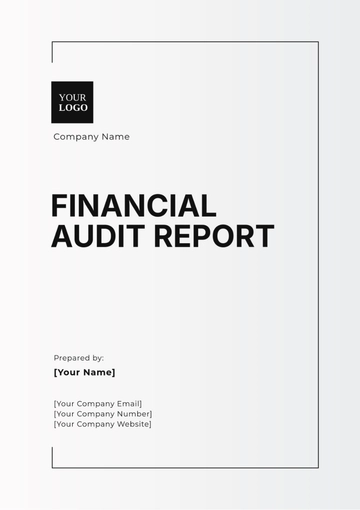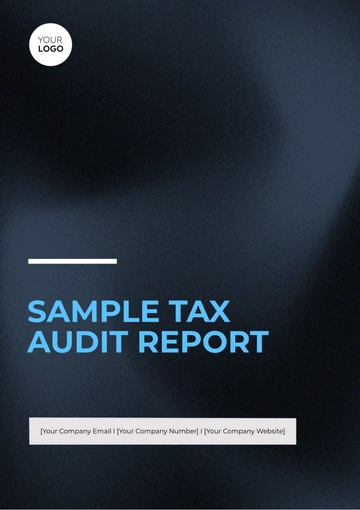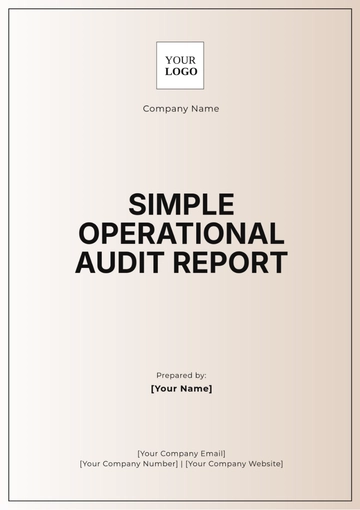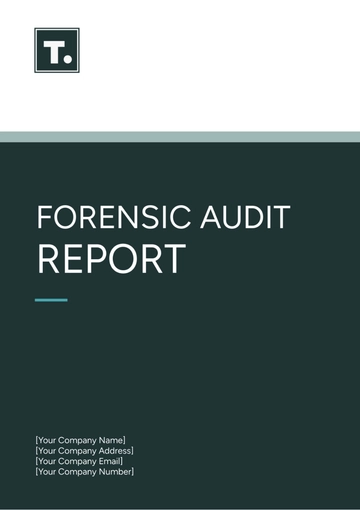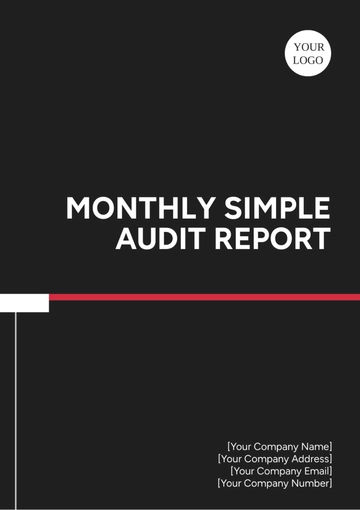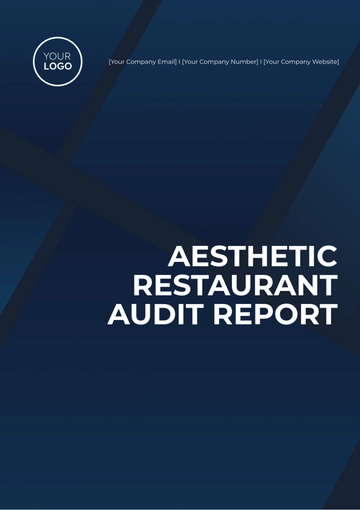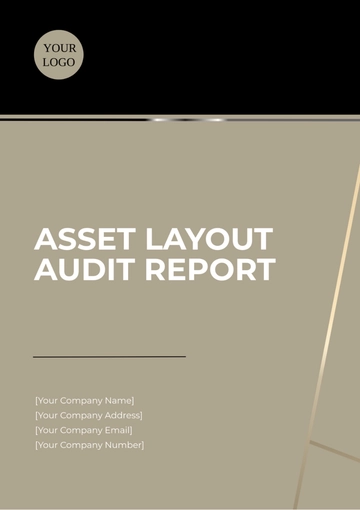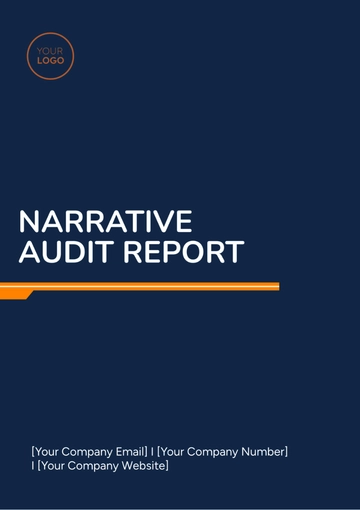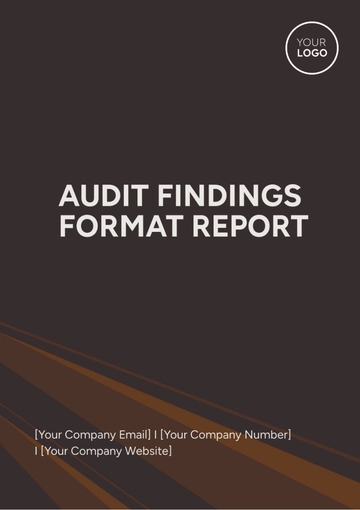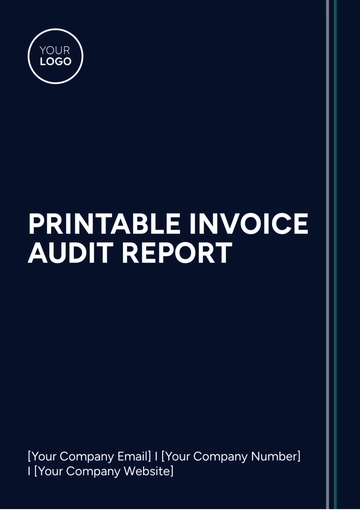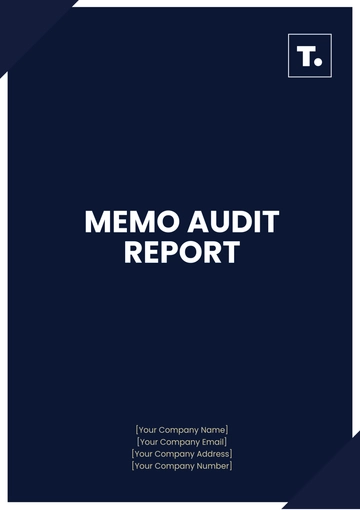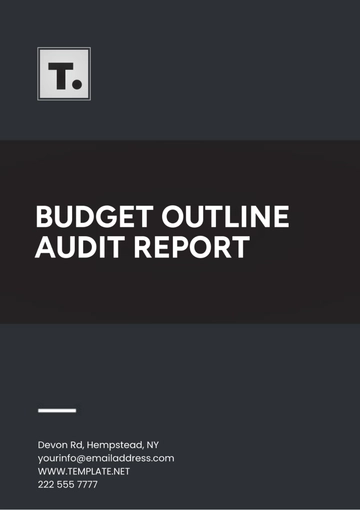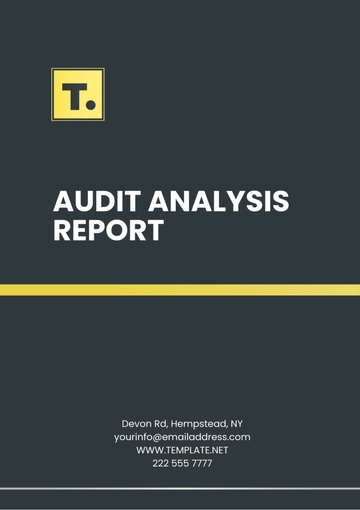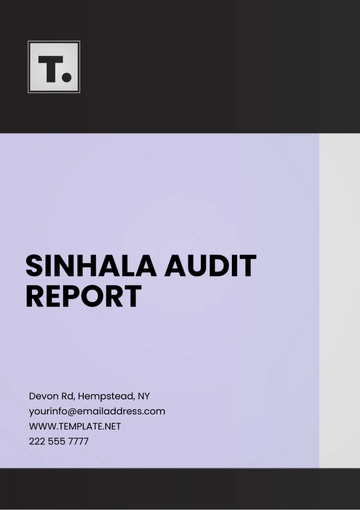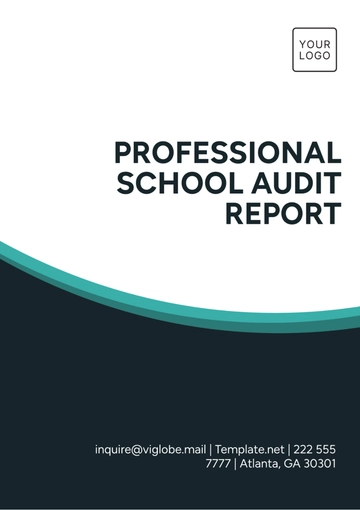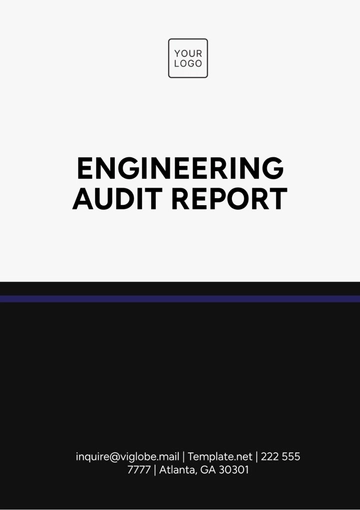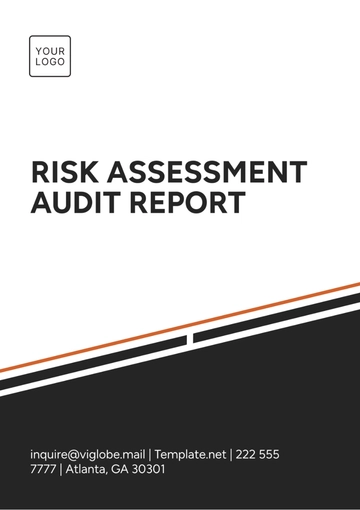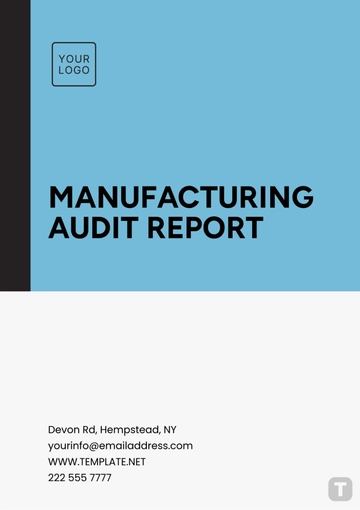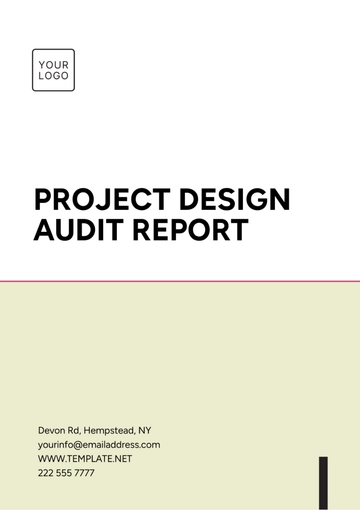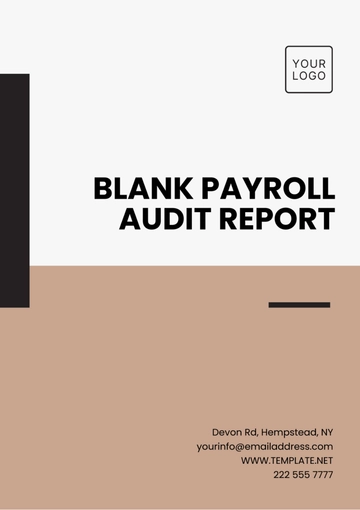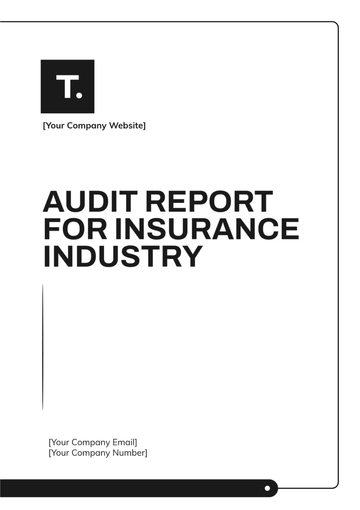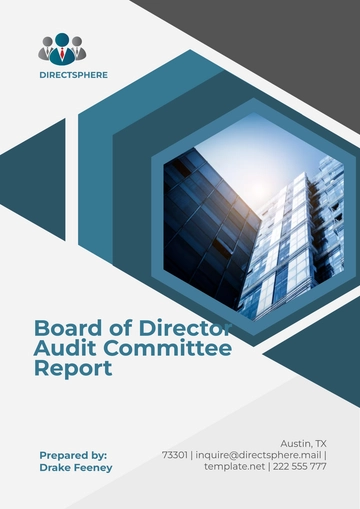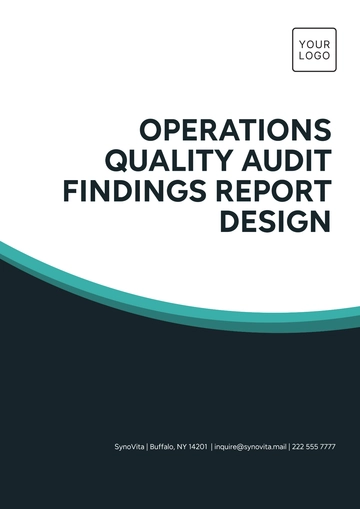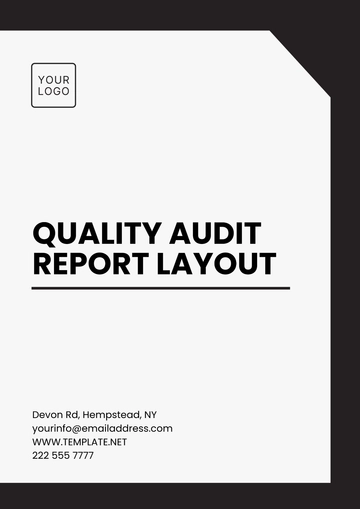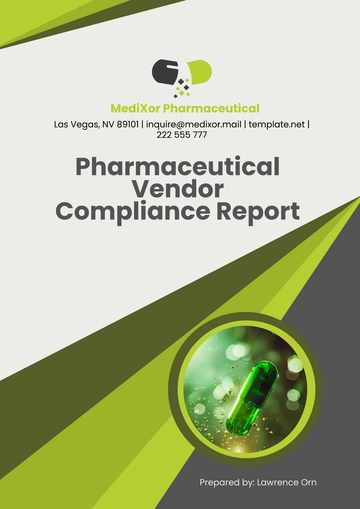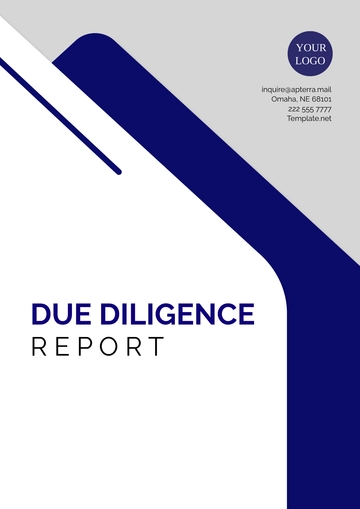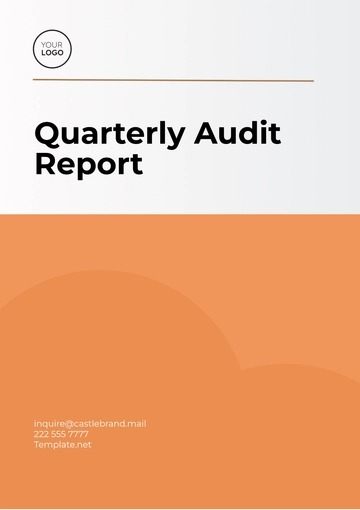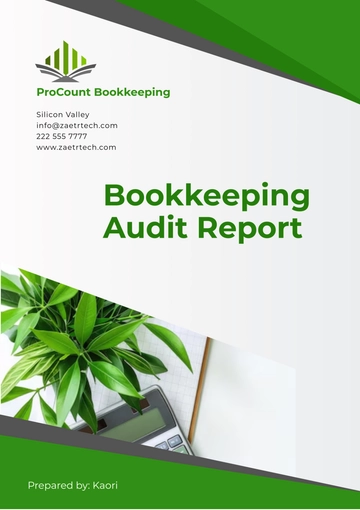Free Printable Church Audit Report
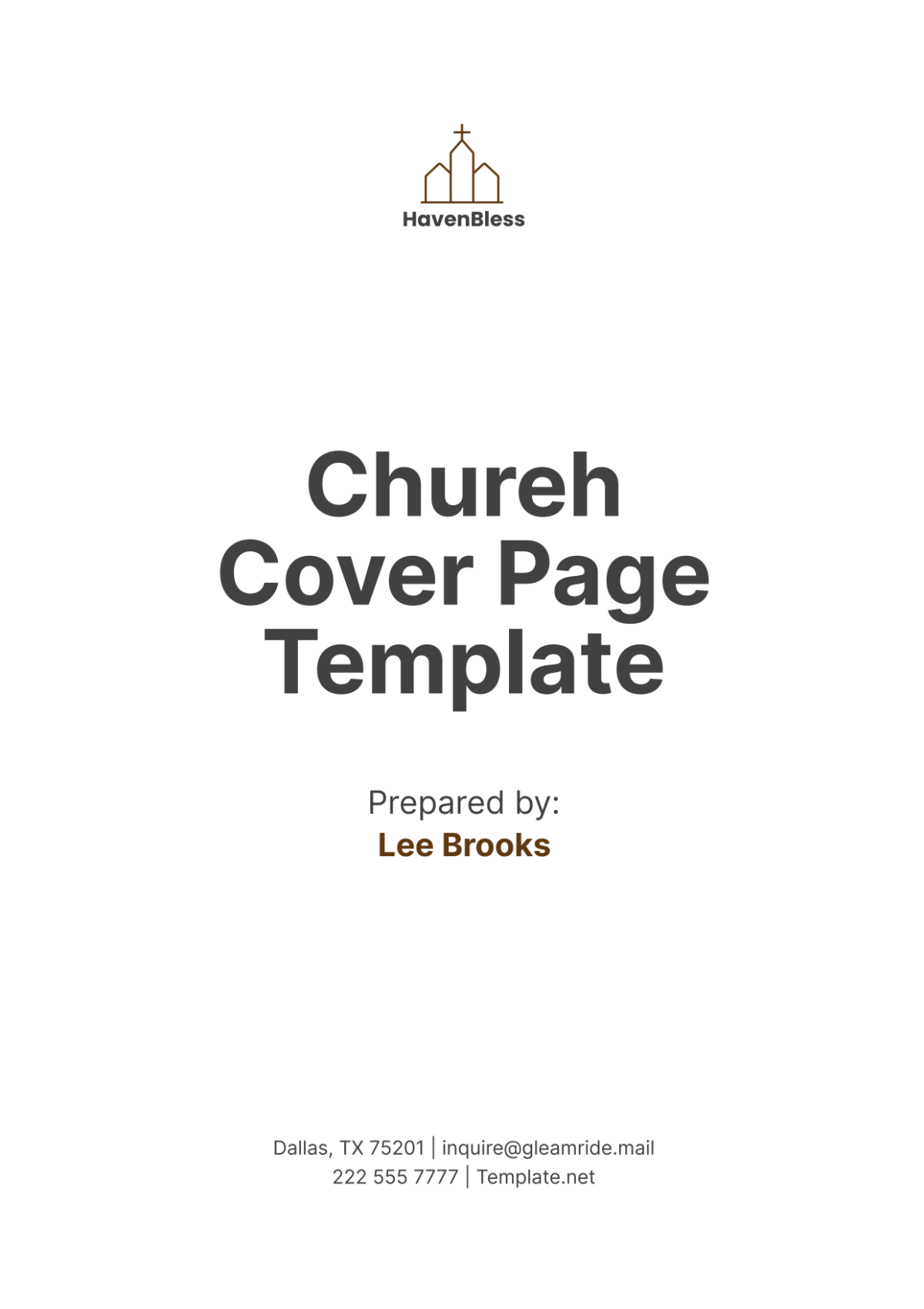
I. Introduction
A. Purpose of the Audit
The purpose of this audit is to conduct a thorough examination of the financial operations and practices of [Your Company Name] Church for the fiscal year ending December 31, 2050. This audit aims to provide stakeholders with an objective assessment of the church’s financial health, compliance with internal policies, and adherence to regulatory requirements. By evaluating the church’s financial management and operational practices, the audit seeks to ensure transparency, accountability, and the effective use of resources. The ultimate goal is to identify any discrepancies or inefficiencies that may impact the church’s financial stability and to recommend corrective measures to address these issues.
B. Scope of the Audit
This audit encompasses all financial transactions and records of [Your Company Name] Church for the fiscal year ending December 31, 2050. The scope includes a comprehensive review of several key areas:
Cash Receipts and Disbursements: Examination of all incoming and outgoing cash flows, including donations, offerings, and payments for services or goods.
Bank Reconciliations: Verification that the church’s bank statements align with its internal cash records to ensure accuracy and identify any discrepancies.
Payroll and Personnel Expenses: Assessment of payroll processes and personnel expense management to ensure accurate and timely compensation and adherence to relevant regulations.
Fixed Assets Management: Evaluation of the management and recording of the church’s long-term assets, such as property and equipment, to ensure proper accounting and safeguarding.
Budgeting and Financial Planning: Review of the church’s budgeting processes and financial planning practices to determine their effectiveness and alignment with the church’s strategic goals.
Compliance with Internal Controls and Policies: Assessment of adherence to established internal controls and policies to ensure that financial activities are conducted in a manner consistent with organizational standards and regulatory requirements.
C. Methodology
The audit was performed using a structured approach in line with generally accepted auditing standards (GAAS). The methodology involved several key steps:
Reviewing Financial Statements and Records: Comprehensive analysis of the church’s financial statements, including the balance sheet, income statement, and cash flow statement, to assess their accuracy and completeness.
Conducting Interviews with Key Personnel: Engaging with key staff members involved in financial management and operations to gain insights into internal processes and identify any potential areas of concern.
Performing Tests of Transactions: Selecting and testing a sample of transactions to verify their accuracy, proper authorization, and compliance with internal policies.
Assessing the Effectiveness of Internal Controls: Evaluating the design and implementation of internal controls to ensure they are effective in preventing and detecting errors or fraud.
Evaluating Compliance with Applicable Laws and Regulations: Reviewing compliance with relevant legal and regulatory requirements to ensure the church operates within the boundaries of the law and industry standards.
II. Executive Summary
A. Summary of Findings
The audit of [Your Company Name] Church’s financial operations for the fiscal year ending December 31, 2050, revealed several key findings:
Financial Management: The church’s financial management practices are generally sound, with a robust system for tracking and recording transactions. However, there are areas where improvements could enhance overall financial control and efficiency.
Documentation and Record-Keeping: Financial records are accurately maintained, and transactions are well-documented. Nonetheless, a few instances of incomplete documentation were noted, which could pose risks to financial accuracy and accountability.
Internal Controls: Internal controls are in place and functioning effectively in most areas. However, there are opportunities to strengthen controls, particularly in cash handling and payroll processing, to mitigate risks and improve overall financial integrity.
B. Key Recommendations
Based on the audit findings, several key recommendations have been identified:
Enhance Cash Handling Procedures: Implement more rigorous cash handling procedures to ensure all cash receipts are accurately recorded and deposited promptly. This includes improving controls over cash collection, recording, and deposit processes.
Strengthen Payroll Processing Controls: Introduce additional checks and balances in the payroll process to prevent errors and fraud. This includes implementing more detailed verification procedures and ensuring that payroll calculations are accurate.
Update Internal Control Policies: Regularly review and update internal control policies to ensure they remain relevant and effective in the face of evolving regulatory requirements and operational changes. This will help maintain robust financial oversight and mitigate potential risks.
III. Financial Statements
A. Statement of Financial Position
The Statement of Financial Position provides a snapshot of the church’s financial position as of December 31, 2050. It outlines the church’s assets, liabilities, and net assets, offering insights into its financial health.
1. Assets
Assets | Amount ($) |
|---|---|
Cash and Cash Equivalents | 150,000 |
Accounts Receivable | 20,000 |
Fixed Assets | 500,000 |
Investments | 100,000 |
Total Assets | 770,000 |
Cash and Cash Equivalents: Represents the funds readily available for use, including cash on hand and in bank accounts. The amount of $150,000 reflects a stable cash position, providing sufficient liquidity for operational needs.
Accounts Receivable: Comprises amounts owed to the church by individuals or entities for services rendered or donations pledged. The $20,000 balance indicates outstanding receivables that are expected to be collected.
Fixed Assets: Includes property, buildings, and equipment owned by the church, valued at $500,000. This figure reflects the church’s investment in long-term assets necessary for its operations.
Investments: Represents funds invested in financial instruments or entities, totaling $100,000. These investments generate income and contribute to the church’s financial growth.
2. Liabilities
Liabilities | Amount ($) |
|---|---|
Accounts Payable | 30,000 |
Long-term Debt | 200,000 |
Total Liabilities | 230,000 |
Accounts Payable: Reflects amounts the church owes to vendors or suppliers for goods and services received, totaling $30,000. This liability indicates the church’s short-term obligations.
Long-term Debt: Represents loans or other borrowings that are due beyond the current fiscal year, amounting to $200,000. This debt is typically associated with financing large purchases or projects.
3. Net Assets
Net Assets | Amount ($) |
|---|---|
Unrestricted Net Assets | 400,000 |
Temporarily Restricted | 100,000 |
Permanently Restricted | 40,000 |
Total Net Assets | 540,000 |
Unrestricted Net Assets: Represents funds available for any purpose as determined by the church’s leadership, totaling $400,000. These assets provide flexibility in managing the church’s operations and initiatives.
Temporarily Restricted: Funds donated with specific conditions that are expected to be met within a defined period, amounting to $100,000. These restrictions are typically related to specific programs or projects.
Permanently Restricted: Donations with stipulations that the principal amount must be preserved in perpetuity, totaling $40,000. The income generated from these funds may be used for designated purposes.
B. Statement of Activities
The Statement of Activities summarizes the church’s revenue and expenses for the fiscal year, providing insights into its operational performance and financial sustainability.
Revenue | Amount ($) |
|---|---|
Contributions | 400,000 |
Program Revenue | 50,000 |
Investment Income | 10,000 |
Total Revenue | 460,000 |
Contributions: Includes donations from members, supporters, and other sources, totaling $400,000. This represents the primary source of revenue for the church.
Program Revenue: Income generated from specific programs or services offered by the church, amounting to $50,000. This revenue supports the church’s various outreach and community initiatives.
Investment Income: Earnings from investments held by the church, totaling $10,000. This income contributes to the church’s financial stability and growth.
Expenses | Amount ($) |
|---|---|
Program Services | 300,000 |
Management and General | 80,000 |
Fundraising | 20,000 |
Total Expenses | 400,000 |
Program Services: Costs associated with the delivery of the church’s programs and services, amounting to $300,000. This includes expenses for outreach, community services, and ministry activities.
Management and General: Administrative and operational expenses, totaling $80,000. This includes salaries, utilities, and other overhead costs necessary for running the church.
Fundraising: Expenses related to fundraising activities and events, amounting to $20,000. This includes costs for organizing events and campaigns to generate support and donations.
Change in Net Assets | Amount ($) |
|---|---|
Net Increase | 60,000 |
Net Increase: Represents the surplus of revenue over expenses, totaling $60,000. This increase in net assets reflects the church’s positive financial performance for the fiscal year.
IV. Cash Receipts and Disbursements
A. Cash Receipts
1. Overview
Cash receipts encompass all funds received by the church, including donations, offerings, and other income sources. The audit found that cash receipts are generally well-documented, but there are opportunities to improve procedures to enhance accuracy and accountability.
2. Detailed Findings
Timely Recording: All donations and offerings are recorded in a timely manner, ensuring that financial records accurately reflect the church’s income. This practice is crucial for maintaining accurate financial statements and tracking cash flows.
Deposit Procedures: While most cash receipts are deposited promptly, there are instances where delays have occurred. Implementing more stringent procedures to ensure timely deposits will help mitigate risks related to cash handling and reduce the potential for errors or misappropriation.
B. Cash Disbursements
1. Overview
Cash disbursements include payments made by the church for various expenses, such as vendor payments, payroll, and operational costs. The audit found that cash disbursements are generally well-controlled, with a few areas where improvements could enhance financial management.
2. Detailed Findings
Authorization and Documentation: Most disbursements are properly authorized and supported by adequate documentation. This ensures that payments are made in accordance with approved budgets and internal policies.
Incomplete Documentation: A few instances were noted where supporting documentation for disbursements was missing or incomplete. Ensuring that all payments are accompanied by proper documentation will help maintain transparency and accountability in financial operations.
V. Bank Reconciliations
A. Overview
Bank reconciliations are performed monthly to ensure that the church’s cash records align with its bank statements. This process is essential for identifying discrepancies and ensuring the accuracy of financial records.
B. Detailed Findings
Reconciliation Procedures: Bank reconciliations are completed and reviewed by appropriate personnel on a regular basis. This practice helps ensure that all cash transactions are accurately recorded and any discrepancies are promptly addressed.
Discrepancies: Some discrepancies were noted between bank statements and cash records. Further investigation is required to resolve these differences and ensure that all transactions are accurately reflected in the church’s financial records.
VI. Payroll and Personnel Expenses
A. Overview
Payroll and personnel expenses constitute a significant portion of the church’s overall expenses. The audit found that payroll processing is generally accurate, but there are opportunities to strengthen controls and improve accuracy.
B. Detailed Findings
Accuracy and Timeliness: Payroll is processed accurately and on time, ensuring that employees are compensated correctly and in accordance with employment agreements. This is crucial for maintaining staff satisfaction and compliance with labor laws.
Verification Procedures: There is a need for enhanced verification procedures to ensure the accuracy of payroll records. Implementing additional checks and balances will help prevent errors and potential fraud, ensuring that payroll processes are reliable and secure.
VII. Fixed Assets Management
A. Overview
Fixed assets include long-term assets such as property, equipment, and vehicles owned by the church. Proper management of fixed assets is essential for maintaining their value and ensuring they are used effectively for the church’s operations.
B. Detailed Findings
Accurate Records: Fixed asset records are accurate and up-to-date, reflecting the church’s investment in long-term assets. This includes detailed information on asset acquisition, depreciation, and disposal.
Physical Inventories: Regular physical inventories of fixed assets should be conducted to ensure that all assets are accounted for and in good condition. Implementing a systematic approach to inventory management will help prevent loss or misappropriation of assets.
VIII. Budgeting and Financial Planning
A. Overview
Budgeting and financial planning are critical to the church’s financial health and sustainability. Effective budgeting ensures that resources are allocated efficiently and supports the church’s strategic goals and objectives.
B. Detailed Findings
Budget Preparation: Budgets are prepared and approved by the appropriate governing body, ensuring that financial plans align with the church’s goals and priorities. This process involves forecasting revenue and expenses and setting financial targets for the upcoming fiscal year.
Budget Reviews: There is a need for more frequent budget reviews and adjustments to reflect changing financial conditions. Regularly reviewing and updating the budget will help the church respond to financial challenges and opportunities effectively.
IX. Compliance with Internal Controls and Policies
A. Overview
Compliance with internal controls and policies is essential to ensure that the church’s financial activities are conducted properly and in accordance with established standards. Internal controls help prevent errors, fraud, and mismanagement.
B. Detailed Findings
Adherence to Policies: Most internal control policies are followed consistently, ensuring that financial activities are conducted in a controlled and transparent manner. This includes adherence to policies related to cash handling, expense approvals, and financial reporting.
Policy Updates: Some internal control policies need to be updated to reflect current practices and regulatory requirements. Regularly reviewing and revising policies will help maintain effective controls and ensure compliance with evolving standards.
X. Conclusion
A. Summary of Recommendations
Strengthen Cash Handling Procedures: Implement more rigorous cash handling procedures to ensure that all receipts are accurately recorded and deposited promptly. This includes enhancing controls over cash collection, recording, and deposit processes.
Enhance Payroll Processing Controls: Introduce additional checks and balances in the payroll process to prevent errors and fraud. This includes implementing detailed verification procedures and ensuring that payroll calculations are accurate.
Update Internal Control Policies: Regularly review and update internal control policies to ensure they remain relevant and effective. This will help maintain robust financial oversight and mitigate potential risks.
Improve Documentation for Disbursements: Ensure that all disbursements are supported by complete and accurate documentation. This includes implementing procedures to verify that all payments are properly documented and authorized.
B. Action Plan
Cash Handling Procedures: Develop and implement new cash handling procedures within the next three months. This includes training staff on the new procedures and monitoring compliance to ensure effective implementation.
Payroll Verification: Enhance payroll verification processes and provide additional training to payroll staff. This includes implementing additional checks and balances to ensure the accuracy of payroll records.
Internal Control Review: Schedule regular reviews of internal control policies and update them as needed. This includes conducting periodic assessments of internal controls to ensure they remain effective and aligned with current practices.
Disbursement Documentation: Implement a system to ensure that all disbursements are supported by complete and accurate documentation. This includes developing procedures for verifying and approving all payments.
C. Follow-Up
A follow-up audit will be conducted within six months to assess the implementation of the recommendations and ensure that corrective actions have been taken. This follow-up will include:
Review of Cash Handling Procedures: Assess the implementation of new cash handling procedures and test for compliance. This includes reviewing documentation and conducting interviews with staff involved in cash handling.
Evaluation of Payroll Controls: Evaluate the effectiveness of enhanced payroll controls and verify their implementation. This includes testing payroll records and reviewing verification procedures.
Internal Control Policies Review: Review the updated internal control policies and assess their effectiveness. This includes evaluating compliance with revised policies and identifying any areas for further improvement.
Verification of Disbursement Documentation: Verify that all disbursements are now properly documented and supported by complete documentation. This includes reviewing a sample of disbursements and assessing the adequacy of supporting documents.
- 100% Customizable, free editor
- Access 1 Million+ Templates, photo’s & graphics
- Download or share as a template
- Click and replace photos, graphics, text, backgrounds
- Resize, crop, AI write & more
- Access advanced editor
Document financial health with the Printable Church Audit Report Template from Template.net. It's customizable and editable, designed for detailed financial reporting. Utilize our Ai Editor Tool to compile audit findings, ensuring transparency and accountability in your church’s financial operations.
You may also like
- Sales Report
- Daily Report
- Project Report
- Business Report
- Weekly Report
- Incident Report
- Annual Report
- Report Layout
- Report Design
- Progress Report
- Marketing Report
- Company Report
- Monthly Report
- Audit Report
- Status Report
- School Report
- Reports Hr
- Management Report
- Project Status Report
- Handover Report
- Health And Safety Report
- Restaurant Report
- Construction Report
- Research Report
- Evaluation Report
- Investigation Report
- Employee Report
- Advertising Report
- Weekly Status Report
- Project Management Report
- Finance Report
- Service Report
- Technical Report
- Meeting Report
- Quarterly Report
- Inspection Report
- Medical Report
- Test Report
- Summary Report
- Inventory Report
- Valuation Report
- Operations Report
- Payroll Report
- Training Report
- Job Report
- Case Report
- Performance Report
- Board Report
- Internal Audit Report
- Student Report
- Monthly Management Report
- Small Business Report
- Accident Report
- Call Center Report
- Activity Report
- IT and Software Report
- Internship Report
- Visit Report
- Product Report
- Book Report
- Property Report
- Recruitment Report
- University Report
- Event Report
- SEO Report
- Conference Report
- Narrative Report
- Nursing Home Report
- Preschool Report
- Call Report
- Customer Report
- Employee Incident Report
- Accomplishment Report
- Social Media Report
- Work From Home Report
- Security Report
- Damage Report
- Quality Report
- Internal Report
- Nurse Report
- Real Estate Report
- Hotel Report
- Equipment Report
- Credit Report
- Field Report
- Non Profit Report
- Maintenance Report
- News Report
- Survey Report
- Executive Report
- Law Firm Report
- Advertising Agency Report
- Interior Design Report
- Travel Agency Report
- Stock Report
- Salon Report
- Bug Report
- Workplace Report
- Action Report
- Investor Report
- Cleaning Services Report
- Consulting Report
- Freelancer Report
- Site Visit Report
- Trip Report
- Classroom Observation Report
- Vehicle Report
- Final Report
- Software Report
